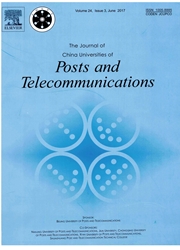

 中文摘要:
中文摘要:
介绍多重输入多重产量(MIMO ) 继电器隧道能提供重要电容获得。并且开发有效电源分配策略完成电源效率并且在 amplify-and-forward 继电器系统改进隧道电容是很重要的。这篇文章在继电器节点(RN ) 和接收装置(处方) 与多重天线调查一个二跳跃 MIMO 继电器系统。选择(MCAS ) 和有 eigen 分解(MCED ) 的最大化的能力策划的有天线的最大化的能力被建议高效地不到第一和第二在 RN 在天线之中分配力量跳跃有限情形。分析和模拟结果证明 MCED 和 MCAS 能与一致功率分配(UFA ) 相比改进隧道电容在大多数学习区域的计划。MCAS 与可接受的能力损失与 MCED 忍受比较,但是由节省隧道状态信息(CSI ) 反馈到传输器(TX ) 降低复杂性。而且当 RN 接近处方时, UFA 的表演作为第一的表演离上面的界限也靠近,跳跃被限制。
 英文摘要:
英文摘要:
Introducing multiple-input multiple-output(MIMO) relay channel could offer significant capacity gain. And it is of great importance to develop effective power allocation strategies to achieve power efficiency and improve channel capacity in amplify-and-forward relay system. This article investigates a two-hop MIMO relay system with multiple antennas in relay node (RN) and receiver (RX). Maximizing capacity with antenna selection(MCAS) and maximizing capacity with eigen-decomposition (MCED) schemes are proposed to efficiently allocate power among antennas in RN under first and second hop limited scenarios. The analysis and simulation results show that both MCED and MCAS can improve the channel capacity compared with uniform power allocation (UPA) scheme in most of the studied areas. The MCAS bears comparison with MCED with an acceptable capacity loss, but lowers the complexity by saving channel state information (CSI) feedback to the transmitter (TX). Moreover, when the RN is close to RX, the performance of UPA is also close to the upper bound as the performance of first hop is limited.
 同期刊论文项目
同期刊论文项目
 同项目期刊论文
同项目期刊论文
 期刊信息
期刊信息
